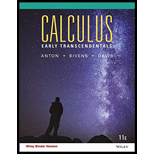
Concept explainers
If
Want to see the full answer?
Check out a sample textbook solution
Chapter 15 Solutions
CALCULUS EARLY TRANSCENDENTALS W/ WILE
Additional Math Textbook Solutions
Calculus & Its Applications (14th Edition)
Calculus: Early Transcendentals (2nd Edition)
Single Variable Calculus: Early Transcendentals (2nd Edition) - Standalone book
Precalculus: Concepts Through Functions, A Unit Circle Approach to Trigonometry (4th Edition)
Calculus, Single Variable: Early Transcendentals (3rd Edition)
Precalculus Enhanced with Graphing Utilities (7th Edition)
- 22. Find the center for each of the following groups . a. in Exercise 34 of section 3.1. b. in Exercise 36 of section 3.1. c. in Exercise 35 of section 3.1. d., the general linear group of order over. Exercise 34 of section 3.1. Let be the set of eight elements with identity element and noncommutative multiplication given by for all in (The circular order of multiplication is indicated by the diagram in Figure .) Given that is a group of order , write out the multiplication table for . This group is known as the quaternion group. Exercise 36 of section 3.1 Consider the matrices in , and let . Given that is a group of order 8 with respect to multiplication, write out a multiplication table for. Exercise 35 of section 3.1. A permutation matrix is a matrix that can be obtained from an identity matrix by interchanging the rows one or more times (that is, by permuting the rows). For the permutation matrices are and the five matrices. Given that is a group of order with respect to matrix multiplication, write out a multiplication table for .arrow_forwardDetermine the area of ABC if A=2,1,B=5,3,andC is the reflection of the B across the x-axis.arrow_forwardUse a software program or a graphing utility to write v as a linear combination of u1, u2, u3, u4, u5 and u6. Then verify your solution. v=(10,30,13,14,7,27) u1=(1,2,3,4,1,2) u2=(1,2,1,1,2,1) u3=(0,2,1,2,1,1) u4=(1,0,3,4,1,2) u5=(1,2,1,1,2,3) u6=(3,2,1,2,3,0)arrow_forward
- Let K = Span{ t-t, 1+3t}, then dim K = %3Darrow_forward3arrow_forward15. Two right triangles are graphed on the coordinate plane. Triangle ABC has vertices A(0,0), B(3,0), and C (0,4). Triangle DEF has vertices D(3,7), E (3, –2), and F(-9,-2). Which of the following transformations cannot be used as part of a proof that ABC is similar to DEF? O A. Dilate ABC with a center at (0, 0) and a scale factor of 3. O B. Reflect ABC over the line y = 0. C. Rotate ABC 90° counterclockwise around the origin. O D. Translate ABC using the transformation (x, y) → (x + 3,y – 2)arrow_forward
- 9.arrow_forwardpolic ...the co.... 3. Prove that a general linear transformation maps circles to circles.arrow_forward3 Graph the Image of polnts A and B after a reflection over the x-axls. UNDO REDO RE CLICK TO SELECT 10 O POINT A O POINT B 6 -5 2 8 9 10 11 12 13 14 15 16 17 18 -10 9 8 43 -2 10 acer DIIarrow_forward
- [2.23] Find the extreme points and directions of the following polyhedral sets. S = {x:x +2x2 + x3 s 10,–x¡ + 3x2 = 6,x1,x2, x3 2 0} . b. S= {x:2x +3x2 2 6, x1 – 2x2 = 2, x1, x2 2 0} . а. %3Darrow_forwardShow that S {x€R* |2,• 24. • O} is/isn't %3D convexarrow_forward1. The coordinates of the vertices of parallelogram ABCD are A(-2, 2), B(3,5), C(4, 2), and D(-1,-1) . State the coordinates of the vertices of parallelogram A"B*C"D" that result from the transformation y-is • T2-3.arrow_forward
 Elementary Geometry For College Students, 7eGeometryISBN:9781337614085Author:Alexander, Daniel C.; Koeberlein, Geralyn M.Publisher:Cengage,Algebra & Trigonometry with Analytic GeometryAlgebraISBN:9781133382119Author:SwokowskiPublisher:Cengage
Elementary Geometry For College Students, 7eGeometryISBN:9781337614085Author:Alexander, Daniel C.; Koeberlein, Geralyn M.Publisher:Cengage,Algebra & Trigonometry with Analytic GeometryAlgebraISBN:9781133382119Author:SwokowskiPublisher:Cengage Elementary Linear Algebra (MindTap Course List)AlgebraISBN:9781305658004Author:Ron LarsonPublisher:Cengage Learning
Elementary Linear Algebra (MindTap Course List)AlgebraISBN:9781305658004Author:Ron LarsonPublisher:Cengage Learning Linear Algebra: A Modern IntroductionAlgebraISBN:9781285463247Author:David PoolePublisher:Cengage Learning
Linear Algebra: A Modern IntroductionAlgebraISBN:9781285463247Author:David PoolePublisher:Cengage Learning Algebra: Structure And Method, Book 1AlgebraISBN:9780395977224Author:Richard G. Brown, Mary P. Dolciani, Robert H. Sorgenfrey, William L. ColePublisher:McDougal Littell
Algebra: Structure And Method, Book 1AlgebraISBN:9780395977224Author:Richard G. Brown, Mary P. Dolciani, Robert H. Sorgenfrey, William L. ColePublisher:McDougal Littell College AlgebraAlgebraISBN:9781305115545Author:James Stewart, Lothar Redlin, Saleem WatsonPublisher:Cengage Learning
College AlgebraAlgebraISBN:9781305115545Author:James Stewart, Lothar Redlin, Saleem WatsonPublisher:Cengage Learning





